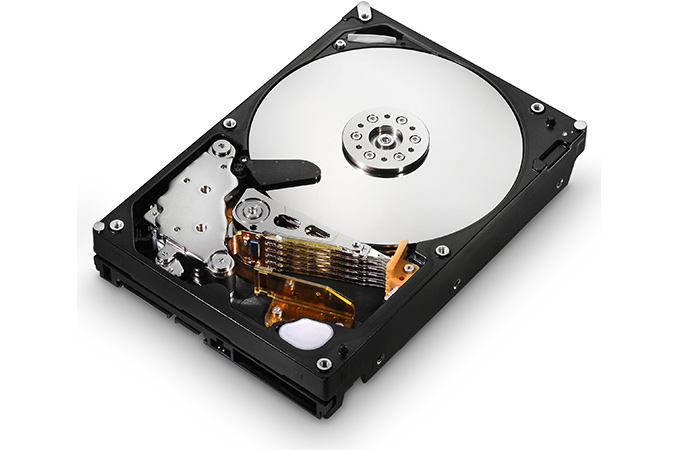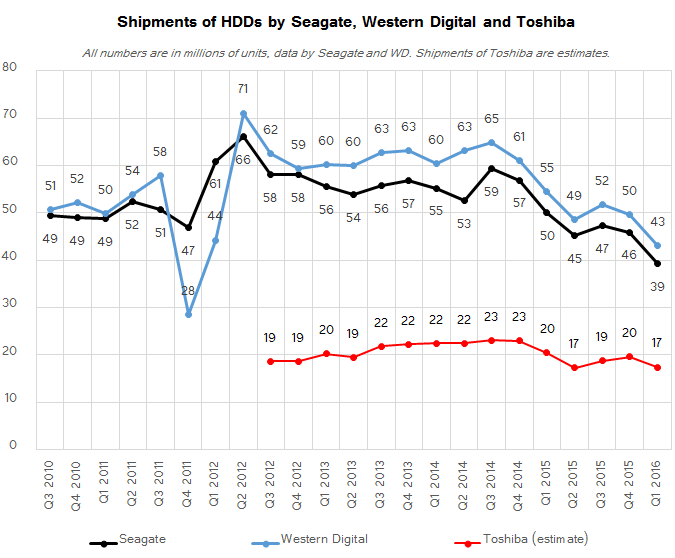Western Digital to Shut Down HDD Manufacturing Facility, Increase Production of SSDs
by Anton Shilov on July 19, 2018 4:00 PM EST- Posted in
- HDDs
- Storage
- SSDs
- Western Digital

Western Digital this week announced plans to shut down its HDD assembly facility (near Kuala Lumpur, Malaysia) by the end of 2019, and then sell the property. The factory has been used for several decades, but Western Digital says that the total available market for client hard drives has been shrinking in the recent years and will continue to do so in the coming years, which is why it does not need the extra manufacturing capacities that it will not be able to use.
Western Digital is a vertically integrated maker of hard drives. The company produces all the components of HDDs in-house, everything from media substrates to platters and from head substrates to HGAs (head gimbal assembly) and HSAs (head stack assembly). Obviously, it performs final assembly and testing too. At present Western Digital has three factories that produce hard drives: the largest one is located in Bang Pa-In (Thailand), the second largest one is situated near Kuala Lumpur in Petaling Jaya (Malaysia), and the smallest one is sited in Prachinburi (Thailand). Meanwhile only the largest one is more or less vertically integrated and makes not only HDDs, but also many of their components (see the table below for details).
The total available market of hard drives dropped to around 400 million units in 2017, down from around 550 million units in 2014. As a result, both Seagate and Western Digital have been reducing their HDD manufacturing capacities in the recent years. Seagate shut down its HDD assembly factory in Suzhou, China, in 2017, whereas Western Digital closed down its head wafer facility in Odawara, Japan, in 2016. While the HDD TAM has been on the decline for years now, sales of nearline hard drives featuring a massive capacity for datacenters have been growing. Therefore, neither Western Digital nor Seagate have plans to limit production of these products.
“In response to declining long-term demand for client HDDs, Western Digital has taken steps to rationalize its HDD manufacturing operations globally,” a statement by Western Digital published by The Register reads. “The company will decommission its HDD manufacturing facility in Petaling Jaya, Selangor, by the end of calendar 2019. This transition will be executed in close collaboration with employees, customers, supply partners and other critical stakeholders.”
The production facility in question was established in 1973 and initially made semiconductors. Since the factory had a clean room, it was relatively easy to convert it to an HDD assembly plant in 1994. After the facility is decommissioned, Western Digital intends to sell the site near Kuala Lumpur. What remains unclear is what is going to happen to Western Digital’s sites near Johor and Kuching, where the company makes HDD components. The company also did not disclose its plans for its HDD R&D facility near Kuala Lumpur that was added to the plant in 2010 – 2011 and cost $1.2 billion.
Instead of making hard drives in Malaysia, Western Digital says it plans to expand production of SSDs in the country and will commission another SSD assembly factory in Penang in the coming months.
“Market transformation is driving increased adoption of SSDs and NAND flash in traditional HDD applications,” the statement by Western Digital reads. The change has contributed to growth in SSD/NAND flash and declining long-term demand for client HDDs. Consequently, Western Digital plans to expand SSD manufacturing in Penang. The company is in the final stages of commissioning its second SSD facility in Penang, which will go into production in the coming months.”
It is noteworthy that production of SSDs is relatively easy and cheap. Assembly of SSDs does not require state-of-the-art facilities, unlike production of NAND flash memory and assembly of HDDs. Meanwhile, by adding another SSD production plant in Malaysia, Western Digital will have three SSD assembly factories: one in Shanghai, China and two others in Penang, Malaysia.
| Western Digital's's Manufacturing, Development, Marketing and Administrative Facilities | ||||||||
| Location | Primary Use | Type of Products* | Approximate Area | Ownership | ||||
| USA | California | Fremont | R&D, Manufacturing of head wafers |
HDDs | 392,000 ft² | Owned | ||
| Irvine | R&D, Administrative, Marketing, Sales |
490,000 ft² | Leased | |||||
| San Jose | R&D, Product/Head/Media Development, Manufacturing of head wafers |
2,887,000 ft² | Owned/Leased | |||||
| Milpitas | R&D, Administrative, Marketing, Sales, Operations |
SSDs | 589,000 ft² | Owned | ||||
| Colorado | Longmont | R&D | HDDs | 62,000 ft² | Leased | |||
| Minnesota | Rochester | Product Development | 118,000 ft² | |||||
| China | Shanghai | Assembly & Test of NAND Flash ICs | SSDs | 715,000 ft² | Owned | |||
| Shenzhen | Manufacturing of Media, Administrative |
HDDs | 548,000 ft² | Owned/Leased | ||||
| Japan | Fujisawa | Product Development | 661,000 ft² | Owned | ||||
| Malaysia | Johor | Manufacturing of Substrates | 271,000 ft² | Owned | ||||
| Kuala Lumpur | R&D, Manufacturing of HDDs |
1,074,000 ft² | ||||||
| Kuching | Manufacturing and Development of Substrates | 285,000 ft² | ||||||
| Penang | Assembly and Test, Manufacturing of Media and SSDs, and R&D | SSDs | 1,075,000 ft² | |||||
| Singapore | R&D, Administrative |
SSDs (?) | 324,000 ft² | Leased | ||||
| Thailand | Bang Pa-In | R&D, Slider Fabrication, Manufacturing of HDDs, Manufacturing of HGAs |
HDDs | 1,665,000 ft² | Owned | |||
| Novanakorn | Manufacturing of HGAs | 290,000 ft² | ||||||
| Prachinburi | Manufacturing of HDDs | 729,000 ft² | ||||||
| India | Bangalore | R&D, Marketing, Administrative |
SSDs | 220,000 ft² | ||||
| Israel | Kfar Saba | R&D, Marketing, Administrative |
167,000 ft² | |||||
| Tefen | 64,000 ft² | |||||||
*Products originally developed/made in the facility.
Related Reading
- Seagate to Shut Down One of Its Largest HDD Assembly Plants
- Western Digital Launches Ultrastar DC HC530 14 TB PMR with TDMR HDD
- HGST Ultrastar 7K6 & 7K8 Enterprise HDDs: Up to 8 TB, 9th Gen PMR
- Western Digital Now Shipping 14 TB HDDs: HGST Ultrastar Hs14 with 1000 Gb/in2
Sources: The Register, TheEdgeMarkets











24 Comments
View All Comments
baka_toroi - Thursday, July 19, 2018 - link
For long-term unplugged storage, which technology is currently more durable overall? SSDs or HDDs? My greatest fear with this shift in storage technology is related to that.wrkingclass_hero - Thursday, July 19, 2018 - link
HDD, but film and magnetic tape last longer, and there is optical media that is advertised as lasting 100 years.JoeyJoJo123 - Thursday, July 19, 2018 - link
As wrkingclass_hero stated, SSDs aren't particularly well suited to cold storage. HDDs are better, but not the "best". HDD cold storage should be suitable for personal use if a user stores it in appropriate conditions (ie: not next to electrical/magnetic fields, not in damp musty environments like an attic, etc.). Magnetic and optical media is probably the best in terms of longevity, but have slower read/write speeds and may require specialized interfaces, depending on the medium.So yeah, if it's just personal long term cold storage, my advice is just 2 quality large enough HDDs, keep 1 at your place, 1 at a friend's house or PO box or other air conditioned area. Every month store your necessary backups to the encrypted HDD and swap it with your extra, taking the other one back home with you. You could alternatively use bluray media, but writing, write-checking, and data encryption on these is more cumbersome. In this way, backup data is always semi-recent, at most you've lost less than 2 months of important data, you're always checking the HDD every other month for failure, you have easy whole-drive encryption through software on your PC, so even if the drive is stolen, it's not easy to get your info, etc.
JoeyJoJo123 - Thursday, July 19, 2018 - link
Alternatively, purchase cloud storage (dropbox, etc.) and just upload encrypted, password protected, compressed 7zip files to it on a periodic basis. I don't use cloud storage services, but some people might find the convenience better there. I visit my parents every month so this is just when I do my backup drive swap.jordanclock - Friday, July 20, 2018 - link
That's not an alternative, that's an addition. Cloud storage is one copy of data in one location.Best way to think of copies of data: If you have two, you have one. If you have one, you have none.Dodozoid - Sunday, July 22, 2018 - link
Not if you synchronize the data over multiple devices. I do that with OneDrive (albeit with relatively low volume of data). It is stored on Microsoft servers and on 6 PCs on different sites I use with different frequency. If anything happens to any of the computers or online storage, there are always semi-recent offline backups on places I use less regularly.philehidiot - Friday, July 20, 2018 - link
I would never use an SSD for long term unplugged storage. I read something a long time ago that if it's not powered for a longish period (~6 months) there can be data loss. I have experience transient malfunction of an SSD after it was unpowered for 3 months. Whether this was a result of being unpowered or not I don't know. It was fixable. Whether this is a problem with more modern SSDs I dunno and it was a long time ago when I read it.EnzoFX - Friday, July 20, 2018 - link
What about for a media server? (which is all about I need storage for, non-critical) Is an SSD better long term? Powered, not cold. I always start to worry with HDDs once they get a few years in. Or start making more noise, etc. Aside from serving up said files faster, will an SSD have a longer lifespan? I feel like this isn't really addressed as SSD's advance so fast. Not even wear from writing, just storing data.The Chill Blueberry - Friday, July 20, 2018 - link
Magnetic tapes are still the best for this type of archiving IIRC.HStewart - Thursday, July 19, 2018 - link
Time has really change - I remember my 1st hard drive was a 5 1/4 in double height drive for IBM PC that was only 5Meg.I am all for switching the HDD to SSD, but I hope that they find a way to lower cost for large amount of storage Just a quick look on amazon
2TB SSD cheapest around $200
2TD HDD cheapest around $50.
The 4TB SSD come in over $1000 currently
The price of SSD's need to come down to truly compete with HDD if desire for extremely large amount of storage is required.